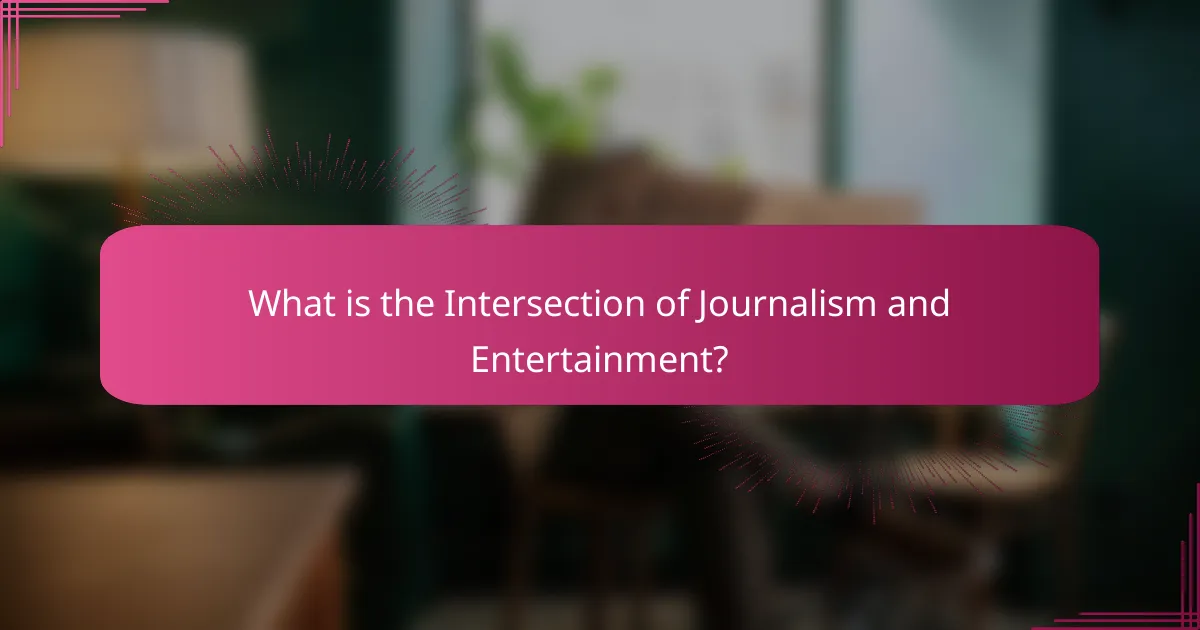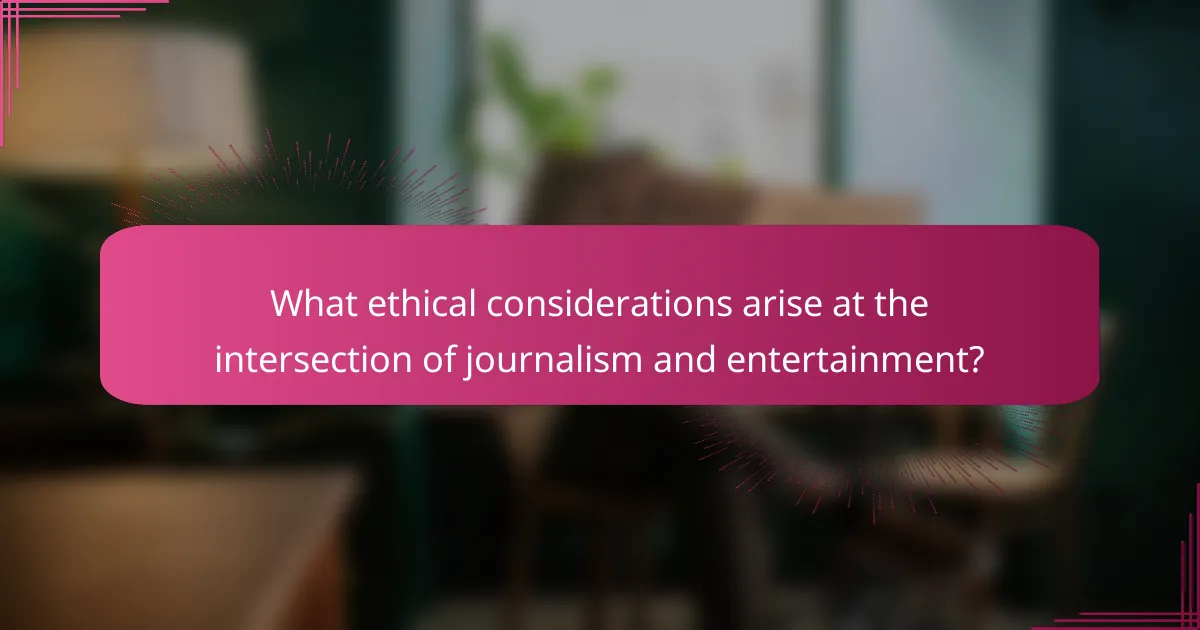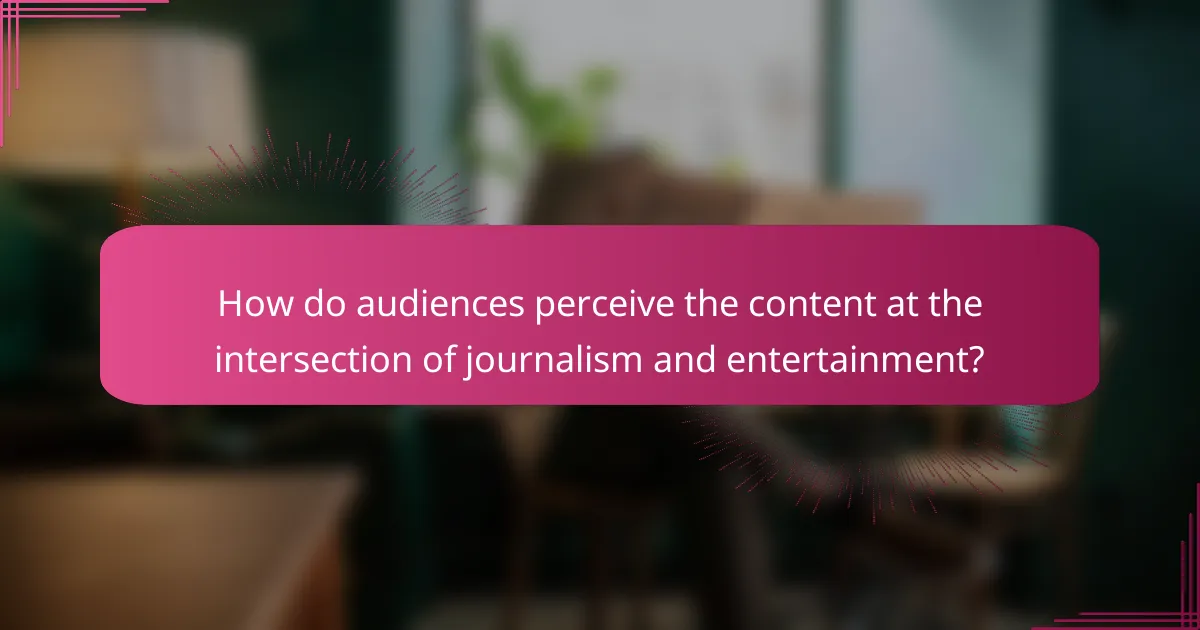The article examines the intersection of journalism and entertainment, highlighting the blending of news reporting with engaging elements to create informative content. It discusses the rise of infotainment, where factual reporting is combined with storytelling techniques, appealing to wider audiences. Key themes include the ethical considerations of accuracy and credibility in this format, as well as the impact on audience trust. Research indicates that a significant portion of the public prefers news presented in an entertaining manner, yet there is a strong demand for maintaining journalistic integrity to avoid sensationalism. The article underscores the delicate balance between engagement and factual reporting in contemporary media consumption.

What is the Intersection of Journalism and Entertainment?
The intersection of journalism and entertainment refers to the blending of news reporting with entertainment elements. This convergence creates content that is both informative and engaging. For example, infotainment combines factual reporting with storytelling techniques typical in entertainment media. This format aims to attract wider audiences while delivering news. Research shows that audiences often prefer news presented in an entertaining manner. A study by the Pew Research Center found that 62% of adults consume news through entertainment platforms. This trend highlights the evolving landscape of media consumption. It raises questions about the ethics of prioritizing engagement over factual accuracy. The intersection ultimately shapes how audiences perceive and trust news sources.
How do journalism and entertainment influence each other?
Journalism and entertainment influence each other through the blending of news storytelling and entertainment formats. Journalistic content often adopts elements from entertainment to engage audiences. This includes the use of narrative techniques, humor, and visual storytelling. Conversely, entertainment media frequently draws from current events for inspiration and plot development. For instance, films and television shows often depict real-world issues, reflecting societal concerns. The rise of infotainment highlights this relationship, where news is presented in an entertaining manner. Research shows that audiences are more likely to engage with news that incorporates entertainment elements. This interplay shapes public perception and discourse on important issues.
What are the historical connections between journalism and entertainment?
Journalism and entertainment have historically intersected in various ways. The origins of journalism can be traced back to the early 17th century, when pamphlets and broadsheets provided news and stories. These publications often included sensational content to attract readers. This blending of fact and entertainment laid the groundwork for modern journalism.
In the 19th century, the rise of newspapers expanded the reach of both journalism and entertainment. Newspapers began incorporating serialized fiction and humor alongside news articles. This practice made news more engaging and accessible to the public.
The advent of radio and television further blurred the lines between journalism and entertainment. News programs started to adopt entertainment formats, such as dramatic storytelling and celebrity interviews. This trend increased viewer engagement and broadened the audience for news content.
In recent decades, the emergence of digital media has intensified this connection. Online platforms often prioritize sensational headlines and entertaining content to capture attention. This shift has led to concerns about the integrity of journalism and the potential for misinformation.
Overall, the historical connections between journalism and entertainment highlight a continuous evolution. This evolution reflects changing audience preferences and technological advancements.
How has the digital age changed the relationship between journalism and entertainment?
The digital age has transformed the relationship between journalism and entertainment by blurring their boundaries. Journalism now often incorporates entertainment elements to engage audiences. This shift is evident in the rise of infotainment, where news is presented in a more entertaining format. Social media platforms amplify this trend, allowing journalists to share content that resonates with entertainment culture. Additionally, audience expectations have evolved, as consumers seek immediate, engaging, and visually appealing news. Data from Pew Research shows that younger audiences prefer news that is entertaining and shareable. Consequently, traditional journalism faces pressure to adapt its style and approach. This evolution reflects a broader cultural shift, where information consumption is intertwined with entertainment.
What current trends are shaping the intersection of journalism and entertainment?
Current trends shaping the intersection of journalism and entertainment include the rise of digital platforms, increased audience engagement, and the blending of news and entertainment formats. Digital platforms allow for immediate news dissemination and interactive content. Social media plays a crucial role in audience engagement, enabling real-time discussions. The blending of formats can be seen in news shows adopting entertainment elements, making stories more relatable. Additionally, investigative journalism is gaining traction through documentary-style storytelling. These trends reflect a shift towards more accessible and engaging content in both fields.
Which platforms are most influential in this intersection today?
Social media platforms are the most influential in the intersection of journalism and entertainment today. Platforms such as Twitter, Facebook, and Instagram play crucial roles in shaping public discourse. They facilitate real-time news sharing and audience engagement. Twitter is particularly significant for breaking news and trending topics. Facebook allows for extensive community discussions and content sharing. Instagram offers visual storytelling that enhances narrative journalism. These platforms have transformed how news is consumed and shared. According to a Pew Research study, 53% of U.S. adults get news from social media. This statistic highlights the growing reliance on these platforms for information.
How are audience preferences evolving in this space?
Audience preferences in the intersection of journalism and entertainment are increasingly favoring authenticity and engagement. Audiences now prefer content that blends factual reporting with storytelling elements. This shift reflects a desire for relatable narratives that resonate emotionally.
Research from the Pew Research Center indicates that 60% of Americans value news that includes personal stories. Additionally, audiences are gravitating towards platforms that facilitate interaction, such as social media. Data shows that 45% of users engage with news content through comments or shares.
Moreover, there is a growing preference for diverse voices and perspectives in storytelling. A survey by the American Press Institute found that 70% of respondents appreciate media that represents various communities. These evolving preferences indicate a demand for journalism that is not only informative but also inclusive and engaging.

What ethical considerations arise at the intersection of journalism and entertainment?
Ethical considerations at the intersection of journalism and entertainment include accuracy, credibility, and audience manipulation. Journalists must ensure that information is factual and not sensationalized for entertainment purposes. This is crucial as misleading content can erode public trust. Additionally, the blending of news and entertainment can lead to conflicts of interest. For example, journalists may prioritize engaging stories over objective reporting. Ethical guidelines, such as those from the Society of Professional Journalists, emphasize the importance of truthfulness and integrity in reporting. Violating these principles can result in a loss of credibility and trust among audiences.
How do ethical standards differ between journalism and entertainment?
Ethical standards in journalism prioritize truth, accuracy, and accountability. Journalists must verify facts and provide balanced reporting. They adhere to codes of ethics established by organizations like the Society of Professional Journalists. In contrast, entertainment ethics focus on creativity and audience engagement. Entertainment professionals often prioritize storytelling and emotional impact over strict factual accuracy. This can lead to dramatization or embellishment of events. The primary goal in journalism is to inform the public, while entertainment aims to entertain. These differing priorities shape the ethical frameworks that guide each field.
What are the implications of blurred lines between fact and fiction?
The implications of blurred lines between fact and fiction include erosion of trust in media. When audiences cannot distinguish between factual reporting and fictional narratives, skepticism increases. This skepticism can lead to misinformation spreading rapidly. Studies indicate that sensationalized stories are often more shared than factual ones. A 2018 study by Vosoughi, Roy, and Aral found that false news spreads six times faster than true news on Twitter. This phenomenon undermines public discourse and informed decision-making. Furthermore, it complicates the ethical responsibilities of journalists. When entertainment influences news, the integrity of journalism is at risk. The audience may become more entertained than informed, impacting democracy.
How can journalists maintain integrity while engaging in entertainment formats?
Journalists can maintain integrity while engaging in entertainment formats by adhering to ethical standards and prioritizing factual accuracy. They should distinguish between news and entertainment, ensuring that reporting remains objective. Transparency is crucial; journalists must disclose sources and potential conflicts of interest. They should avoid sensationalism, focusing instead on delivering balanced narratives. Engaging with audiences responsibly fosters trust. A study by the Pew Research Center found that 70% of Americans value transparency in journalism. Upholding these principles helps journalists navigate the entertainment landscape while preserving their credibility.
What role does audience trust play in the intersection of journalism and entertainment?
Audience trust is essential at the intersection of journalism and entertainment. It influences how audiences perceive and engage with content. Trust affects the credibility of journalistic reporting within entertainment media. Higher audience trust leads to greater audience loyalty and engagement. According to a 2021 study by the Pew Research Center, 70% of Americans believe that trust in news organizations is critical for democracy. In entertainment journalism, trust can enhance the impact of storytelling and inform public opinion. Therefore, audience trust serves as a foundational element that shapes the relationship between journalism and entertainment.
How can media outlets build and maintain trust with their audiences?
Media outlets can build and maintain trust with their audiences by ensuring transparency and accuracy in reporting. Transparency involves disclosing sources and methodologies used in news gathering. This helps audiences understand how information is verified. Accuracy is achieved by fact-checking and providing balanced viewpoints. According to a 2021 Pew Research Center study, 65% of Americans believe that news organizations should correct mistakes promptly. Consistent engagement with the audience through feedback channels fosters a sense of community. Additionally, adhering to ethical journalism standards enhances credibility. Trust is further strengthened by addressing misinformation swiftly. Regularly updating audiences on corrections and clarifications reinforces reliability.
What strategies can be employed to ensure transparency in reporting?
Implementing clear and consistent communication strategies ensures transparency in reporting. Journalists should disclose their sources when possible to build credibility. Providing context around the information shared enhances understanding. Utilizing fact-checking processes reinforces accuracy in reporting. Engaging with the audience through Q&A sessions fosters trust. Regularly updating information as new facts emerge maintains reliability. Transparency in financial disclosures related to reporting operations is also crucial. These strategies collectively promote a culture of openness in journalism.

How do audiences perceive the content at the intersection of journalism and entertainment?
Audiences perceive content at the intersection of journalism and entertainment as a blend of information and engagement. This perception often hinges on the credibility and presentation of the content. Audiences appreciate entertaining formats that maintain journalistic integrity. Research indicates that 61% of consumers prefer news that is presented in an engaging manner. However, they are wary of sensationalism that can compromise factual reporting. Trust in such content varies significantly based on the source. A study by the Pew Research Center found that 70% of Americans believe that news organizations should prioritize accuracy over entertainment value. This highlights the delicate balance audiences expect from journalism intertwined with entertainment.
What factors influence audience trust in journalism and entertainment content?
Audience trust in journalism and entertainment content is influenced by several key factors. Credibility of the source is paramount. Established organizations with a history of accurate reporting tend to earn more trust. Transparency in reporting also plays a crucial role. When content creators disclose their sources and methods, audiences feel more secure in the information presented.
The quality of the content significantly impacts trust. Well-researched, fact-checked articles foster confidence in the audience. Audience engagement is another factor. Interactive platforms that allow for feedback and discussion tend to build a stronger connection with viewers.
Additionally, ethical standards in journalism, such as impartiality and fairness, enhance trust. Audiences are more likely to trust content that presents multiple viewpoints. Finally, social media influence cannot be overlooked. Content shared by trusted peers or influencers can enhance credibility.
Research by the Pew Research Center shows that 62% of Americans believe that news organizations do not do well in separating fact from opinion. This highlights the importance of clear distinctions in journalism to maintain audience trust.
How do sensationalism and clickbait affect audience perception?
Sensationalism and clickbait significantly distort audience perception. They prioritize emotional reactions over factual accuracy. This leads to a misunderstanding of news events. Audiences may develop skewed views based on exaggerated headlines. Research shows that sensational headlines increase engagement but reduce trust. A study by the Pew Research Center found that 62% of Americans feel misled by sensational news. This results in skepticism towards media sources. Ultimately, sensationalism and clickbait undermine the credibility of journalism.
What are the consequences of audience distrust in media?
Audience distrust in media leads to decreased engagement and viewership. When audiences doubt media credibility, they are less likely to consume content. This can result in lower advertising revenues for media outlets. Additionally, misinformation can spread more easily in an environment of distrust. Audiences may turn to alternative sources, often less reliable, for information. This shift can polarize public opinion and increase societal divisions. Research shows that distrust can diminish the effectiveness of public communication campaigns. Ultimately, a lack of trust undermines the essential role of media in democracy.
What best practices can be adopted to enhance audience engagement and trust?
To enhance audience engagement and trust, prioritize transparency in communication. Clear and honest messaging builds credibility. Consistent content delivery fosters reliability. Engaging storytelling captures audience interest effectively. Utilizing audience feedback improves content relevance. Providing accurate information establishes authority. Personalizing interactions strengthens connections with the audience. Regularly addressing audience concerns enhances trustworthiness. Research indicates that 81% of consumers need to trust a brand before making a purchase (Edelman Trust Barometer, 2021).
How can media professionals balance entertainment value with journalistic integrity?
Media professionals can balance entertainment value with journalistic integrity by adhering to ethical guidelines while engaging audiences. They should prioritize factual reporting and fact-checking to maintain credibility. Incorporating storytelling techniques can enhance engagement without compromising truth. Transparency about sources and methods fosters audience trust. The Society of Professional Journalists emphasizes the importance of minimizing harm and being accountable. By maintaining a clear distinction between news and entertainment, media professionals can satisfy audience interest while upholding ethical standards.
What are effective ways to educate audiences about media literacy?
Effective ways to educate audiences about media literacy include interactive workshops and online courses. Workshops allow participants to engage in discussions and hands-on activities. Online courses can provide flexible learning opportunities. Incorporating real-world examples enhances understanding. Teaching critical thinking skills is essential for analyzing media content. Collaborating with educators and organizations can broaden reach and impact. Research shows that media literacy education increases critical consumption of information. The National Association for Media Literacy Education emphasizes the importance of these methods.
The main entity of the article is the intersection of journalism and entertainment, which explores how news reporting merges with entertainment elements to create engaging content. The article outlines key trends such as the rise of infotainment, the influence of social media platforms, and evolving audience preferences for authenticity and engagement. It addresses ethical considerations, including the importance of accuracy and transparency, while examining the implications of blurred lines between fact and fiction. Additionally, the article discusses strategies for building audience trust and maintaining journalistic integrity in an increasingly entertainment-driven landscape.
